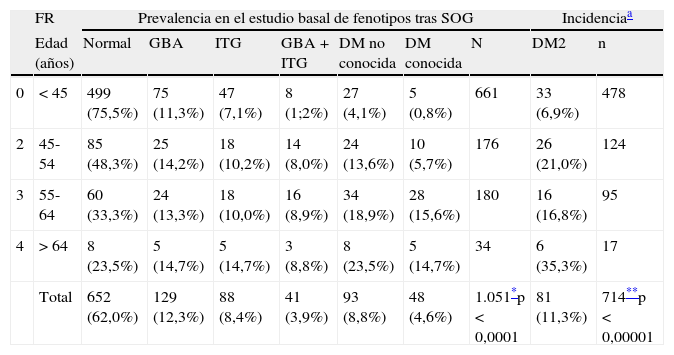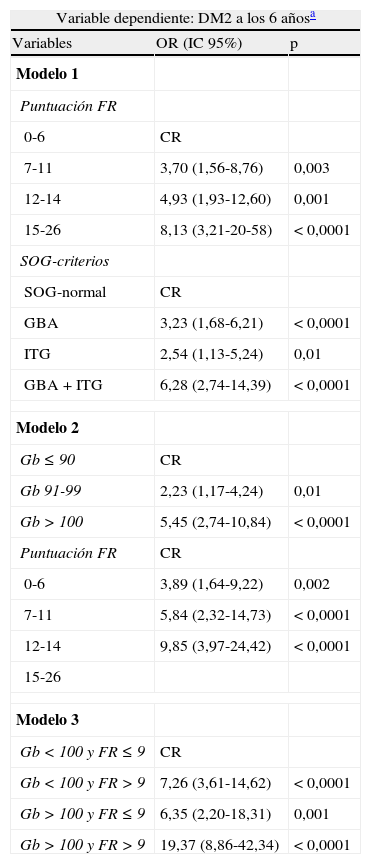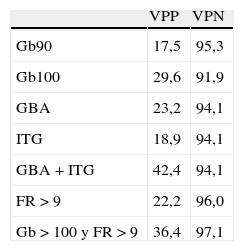El objetivo de este estudio ha sido validar la capacidad del Finnish Diabetes Risk Score (FINDRISC) de predecir el riesgo de diabetes mellitus tipo 2 (DM2) en una población del sudeste español (estudio Pizarra).
Sujetos y métodosEl Estudio Pizarra es un estudio prospectivo de base poblacional desarrollado en la población de Pizarra (Málaga). La primera fase del estudio se realizó en 1997-1998 e incluyó a 1.051 individuos de entre 18-65 años seleccionados aleatoriamente del censo municipal de la localidad. En 2003-2004 los sujetos participantes en el primer estudio fueron reevaluados. Un total de 824 individuos (78,4%) completaron esta segunda fase del estudio. En ambas fases del estudio se administró una sobrecarga oral de glucosa a todos los participantes sin diabetes conocida. Se evaluó la capacidad del FINDRISC para detectar la DM2 no diagnosticada (primera fase: estudio transversal) y en la predicción de la incidencia de DM2 (segunda fase: estudio de cohortes).
ResultadosEl test mostró buenos resultados tanto para detectar DM2 no diagnosticada (área bajo la curva ROC [ROC-AUC]: 0,74) como para predecir DM2 incidente (ROC-AUC: 0,75). La mejor predicción de riesgo de DM2 incidente se encontró en los sujetos con glucemia en ayunas >100mg/dl y un FINDRISC ≥9 (odds ratio [OR]: 19,37; intervalo de confianza del 95% [IC 95%]: 8,86-42,34; p<0,0001).
ConclusionesLos resultados de nuestro estudio muestran que el FINDRISC puede ser una herramienta útil para detectar sujetos con alto riesgo de diabetes en esta población.
The aim of this study was to validate the ability of the Finnish Diabetes Risk Score (FINDRISC) to predict the risk of DM2 in a population of south-eastern Spain (Pizarra Study).
Subjects and methodsThe Pizarra Study is a population-based prospective study developed in the town of Pizarra (Málaga). The first phase of the study was conducted in 1997-1998, including 1051 individuals aged 18-65 years randomly selected from the municipal census of the town. In 2003-2004 the subjects participating in the first study were reassessed. 824 individuals completed the second phase of the study (78.4%). All participants without known diabetes underwent an oral glucose tolerance test both at baseline and follow-up. We evaluated the ability of the FINDRISC to detect undiagnosed DM2 (first phase: cross-sectional study) and in predicting the incidence of DM2 (second phase: cohort study).
ResultsThe test showed good results both to detect undiagnosed DM2 (ROC-AUC 0.74) and to predict incident DM2 (ROC-AUC 0.75). The best prediction of risk of incident DM2 was found in those subjects with fasting glucose >100mg/dl and a FINDRISC ≥9 (OR: 19.37; 95%IC: 8,86-42,34; P<.0001).
ConclusionsThe results of our study show that FINDRISC can be a useful tool to detect subjects at high risk of diabetes in this population.
Artículo
Comprando el artículo el PDF del mismo podrá ser descargado
Precio 19,34 €
Comprar ahora












